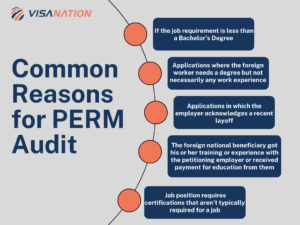Historically, around 30% of PERM Labor Certification cases were selected for audits by the Department of Labor (DOL). However, since the launch of the FLAG system and the expanded online PERM form (including Appendix A), the DOL now relies primarily on Requests for Information (RFIs) to catch inconsistencies between the Prevailing Wage Determination (PWD) and the ETA-9089. These RFIs allow many issues to be clarified before certification delays occur.
While RFIs appear to be the new norm and may sound less frightening than a comprehensive PERM audit, RFIs are no less serious and still require employers to maintain meticulous records so they can respond effectively to requests for information and ultimately avoid a PERM denial. Our attorneys at VisaNation recommend our clients that RFIs should not be treated in the same way as an audit – they require a different approach, and a bulletproof ETA-9141 and ETA-9089 application.
In this article, we’ll explore PERM RFIs and audits, red flags to avoid in your applications, best practices for the PERM process, and ways to avoid PERM denial altogether.
What is a PERM Audit and RFI?
Before RFIs, the Department of Labor largely relied on random or targeted audits, which involved a full investigation into nearly every aspect of the PERM process. If audited, this could delay the entire process by 6+ months.
More commonly used, a PERM RFI is a targeted request by the Department of Labor for specific information where they require clarification or additional details about a PERM labor certification application or Prevailing Wage Determination. In contrast to the PERM audit, the RFI requires employers to verify specific aspects of the case, such as job requirements or employer business details, before moving forward with a decision.
The introduction of the new FLAG system introduced significant changes to the process, such as:
- Integrating both the prevailing wage determination request application (ETA-9141) and PERM application (ETA-9089), replacing the old, separate ICERT and PERM systems.
- The addition of the 9098 Appenix A, which collects information about the beneficiary, including:
- Contact information
- Educational background
- Training qualifications, certifications, and/or licenses
- Specific skills, abilities, and proficiencies
- Work experience
- A checkbox section in the 9089 PERM application for employers to document the specific recruitment methods they used to post the job notice.
- The addition of new, explicit questions designed to check for potential compliance issues, such as whether the employer and employee share dual representation or if the job requirements exceed the SVP level.
PERM Denial Rate
The PERM denial rate in FY 2024 was approximately 4.7%, with 5,031 out of 107,000 processed applications being denied. The denial rate for PERM applications in Q1 of Fiscal Year 2025 was approximately 4.02%.
PERM RFI and Audit Reasons
There are several reasons why you may receive an RFI or audit from the Department of Labor. Here are a few of the most common:
- Inconsistent minimum requirements between the PWD and the PERM
- Mismatched our outdated SOC codes: Any use of the incorrect SOC codes will result in an RFI.
- Mismatched Qualifications: If the foreign worker’s education, training, and experience detailed in Appendix A, do not clearly meet the minimum requirements for the job opportunity as defined elsewhere in the application.
- Restrictive Job Requirements: In the ETA-9089, if the employer answers yes to any of the following, it may be seen as a red flag. The employer must be prepared to justify the reason for requiring any of these:
- The job requires living on the employer’s premises.
- The job involves a combination of different occupations.
- Proficiency in a foreign language is required. Unsupported language requirements are flagged almost automatically.
- The job requirements exceed the standard vocational preparation (SVP) level for that occupation.
- Layoffs: The PERM ETA-9089 form explicitly asks whether your company has had layoffs related to the occupation of the candidate. As the purpose of the PERM process is for an employer to prove to the U.S. Department of Labor that there are no willing, able, and qualified U.S. workers available for the job, a recent layoff in the same or a related occupation directly contradicts that claim.
- Familial Ties: An RFI is almost guaranteed if the employer and the applicant share close familial ties or if the applicant holds an interest in the company, such as stocks or other equity.
- Experience Gained with Sponsoring Employee: The beneficiary got his or her training or experience with the petitioning employer or received payment for education from them. Generally, a worker cannot use experience gained with the sponsoring employer to qualify for the position
- Payment for Filing: The petitioning employer received some payment from the foreign national beneficiary for the PERM Labor application. This is illegal and will lead to a PERM denial.
- Recruitment and Posting Issues: Failure to properly follow all recruitment and notice posting procedures is a common reason for denial. This includes not posting the Notice of Filing or having incorrect dates for advertisements and job orders
- Unclear Travel Requirements and Worksite Descriptions: Vague answers to travel requirements may result in an RFI, such as “occasional travel.” Additionally, if the job has multiple worksites listed inconsistently or unclear remote work arrangements, this can lead to a PERM RFI.
PERM RFI and Audit Processing Times
Our attorneys guide clients with a general processing time of 6 to 8 weeks for RFIs, although response times can vary depending on case complexity and the DOL workload. Overall, RFI’s can be handled much quicker than traditional PERM audits, which can take 6+ months to handle.
How to Avoid a PERM Audit
VisaNation’s legal team takes several steps to avoid PERM RFIs and audits. Our overall strategy has shifted toward preventive accuracy and consistency across every stage of the PERM process. We now focus on:
- Ensuring perfect alignment between job titles, duties, and worksites on the PWD, recruitment, and PERM forms.
- Justifying SOC codes through the substance of job duties rather than generic titles.
- Avoid using “combination of occupations” or “hybrid-role” language unless fully documented and supported.
- Matching wage levels precisely with the education and experience requirements listed on the PERM.
- Providing detailed explanations for any foreign-language requirement. This is one of the most common audit triggers. The DOL expects a clear and documented business necessity (for example, communicating with overseas clients, reviewing source materials, or supporting multilingual customer bases). Unsupported language requirements are flagged almost automatically.
- Addressing any familial relationship between the employer and the sponsored worker. If a familial relationship exists, an RFI or audit is almost guaranteed. The DOL will want evidence that the recruitment was conducted in good faith, without preferential treatment. This typically means demonstrating objective selection criteria, independent decision-makers, and documentation showing that all U.S. applicants were fairly considered.
What is a Perm Audit?
A PERM Audit is a more serious issue when the Department of Labor requests information related to the recruitment process to ensure all proper guidelines were followed. In the event of an audit, the DOL will deem that your recruitment report is insufficient or contains suspicious circumstances that need to be examined more closely. Audits and supervised recruitment are still used, but far less frequently. Traditional audits are now reserved for higher-risk indicators, such as layoffs, related-party employment, or recruitment irregularities. Supervised recruitment remains rare and is typically imposed only when the DOL identifies a pattern of non-compliance.
When a PERM application is chosen for an audit, the petitioning employer will get an audit letter with the documents being requested outlined. There are 30 days from the date of the audit request for the employer to provide the requested information and evidence. It is important to meet this strict deadline to avoid an automatic denial. It is possible to request an extension if necessary.
A PERM labor certificate is one of the primary steps in the employment-based green card process, and likewise, the path to citizenship. One of the requirements of the certification is for employers and foreign workers to meet a set of eligibility criteria.
All employment-based green cards require a PERM, except for the EB-1 and the EB-2 with a National Interest Waiver. Keep in mind that the sponsoring employer is responsible for the entire PERM process from recruitment to the filing process.
PERM Audit Denial Rate
The average denial rate for a PERM after audit is about 40%. So what happens after a PERM denial? After it has been issued by the Department of Labor, your employer has 30 days to take one of two actions. They can either request a reconsideration of the decision by the officer OR request a review by the Board of Alien Labor Certification Appeals (BALCA).
Learn more about PERM Denial After Audit.

How Do I Know If My PERM Application Is Selected for An RFI or Audit?
If your PERM application is selected for an RFI or audit, the DOL will send you an audit notice via the online FLAG (Foreign Labor Application Gateway) system and typically by email as well. The notice will detail the list of additional information or documentation you will need to submit.
PERM Supporting Documents
So when responding to a PERM audit, the supporting documents should include:
- The RFI request
- The dated and signed ETA form 9089
- The completed Notice of Filing
- The prevailing wage determination
- Copies of all documents, including all advertisements placed
- Receipts of purchase when placing ads in places like the radio or television
- All resumes collected during the recruitment
- Signed declarations
These documents will need to be submitted to a Certifying Officer (CO) assigned to your case by the DOL. This CO will be your contact throughout the PERM audit process. It is also important to keep in mind that once an audit has been requested, there is no way to avoid it. Withdrawing your PERM application will not excuse you from the audit.
The Certifying Officer Will Review the Response
The audit notice will also include the deadline for the submission of the requested documentation. The deadline is generally 30 days from the date the audit letter was issued, and failure to meet the deadline may result in application denial.
After submitting the requested information, the CO will review it and decide whether the documentation is complete or not, and whether it is in line with the response on the original ETA 9089. If the CO is satisfied, he or she will approve the application.
However, if the CO deems the submission to be incomplete and/or inconsistent, they may deny the application. Other possible outcomes may be for the CO to request even more documentation or require the petitioning employer to undergo supervised recruitment.
Can the Deadline for PERM RFI or Audit Be Extended?
While the standard deadline for an audit notice is 30 days, the CO has the authority to extend the deadline beyond 30 days if the situation warrants it. If, after the given timeframe, the petitioner fails to respond, the application will be considered to have been abandoned, leading to denial. Additionally, the CO may also decide to require the petitioning employer to conduct supervised recruitment for any of their future labor certification applications for a period of up to two years.
Word of advice to all employers–based on our experience, we recommend you keep any supporting evidence on file for a minimum of five years from the point of filing, just in case an audit is later presented.
These sorts of documents include resumes, advertisements, prevailing wage determinations, etc.
Not all PERM denials occur after an audit. There is always the possibility that your PERM will be denied without an audit. If this happens, you will need to consult with your immigration attorney to determine the appropriate next steps.
Supervised Recruitment Triggers
The next three points are supervised recruitment triggers and should be taken very seriously:
- If the same employer and foreign employee submit an application (following a prior denial) in the same year, this typically triggers an audit.
- The second supervised recruitment trigger is applications by the same employee/employer after an audited case has been withdrawn in the same calendar year. As you can imagine, this type of activity seems suspicious and warrants additional investigation on behalf of DOL.
- The final trigger in this category is applications that are not filed electronically but instead, on paper. While there may be legitimate reasons for this, it’s still grounds for an audit in some cases.
While an audit requires that you send your documents in to be reviewed after your recruitment period, PERM supervised recruitment may be issued before your recruitment process begins. This usually occurs if there have been issues with your PERM applications in the past.
Supervised recruitment may also be mandated even after your recruitment period has ended, meaning that you will need to go through the recruitment process a second time under the supervision of the DOL. During this time, you will need to submit all documents to the CO throughout the process.
In past years, the DOL has released data to suggest which states have the highest PERM filings, and these include California, Texas, New York, New Jersey, and Washington.
It’s necessary to note that the aforementioned points are not automatic. Instead, they should serve as broad guidelines to be mindful of during your application process. Whether you are a sponsoring employer or the foreign worker being sponsored, it’s always advised to seek the help of a reputable immigration lawyer. A professional PERM attorney will best be able to guide you and review the documents provided to avoid a PERM audit altogether.
PERM Denial Procedures
Receiving a PERM Audit is no grounds to panic. If your case has an audit or RFI that leads to a denial, you can file what’s known as a request for reconsideration. This is an appeal to the Department of Labor for the denial to be given a second look for reasons like an application error or other related considerations.
Then, if the DOL refuses to reconsider your case,t he employer can request a review by the Board of Alien Labor Certification (BALCA), which can take more than a year to reach a final decision.
PERM audits, supervised recruitment, and denial appeals can all add a significant amount to your PERM processing time. To get a better feel for what you can account for in your particular case, ask your immigration attorney.
Learn about NIW vs PERM.
PERM Audit FAQs
Below you will find answers to the most commonly asked questions.
Can I submit alternative evidence in the absence of the exact evidence required in the audit request?
The ideal way is to respond to a PERM audit request with the exact evidence requested by the DOL. However, if the primary evidence requested is not available, you may attempt to respond by providing alternative documentation. Apart from the close similarities between the requested primary evidence and the alternative provided, the manner of submission is another factor that will determine whether it will be accepted or not. If you are in this situation, it’s best to work with an immigration lawyer.
How long does the RFI process take?
Generally, petitioning employers are given 30 days after receiving the RFI notice to respond. After receiving the response, it typically takes 6-8 weeks to respond. In some cases, it can take much longer, depending on how quickly the petitioner properly responds to the audit notice with satisfying documents. Ordinarily, the DOL takes an average of six months to process PERM applications. But with an audit request coming into the picture, you may end up being delayed up to ten months or more.
How much does the PERM cost?
Petitioning employers do not have to pay any filing fee for the PERM, as there is no cost attached to the ETA Form 9089. However, some costs will come with publishing job advertisements for the recruitment period.
Is there a way to avoid the PERM requirement?
You may bypass the PERM labor certification requirement if you qualify for certain employment-based green card categories. If you qualify for any of the three subcategories of the EB-1 green card, you will not need to undergo the PERM process. Another option is the EB-2 green card if you qualify for a National Interest Waiver (NIW). For the NIW, you will need to demonstrate that the U.S. would benefit from waiving the PERM requirement, as your proposed endeavor (job or investment) will contribute significantly to the U.S. economy.
What is the prevailing wage determination?
Check out this guide on PERM Prevailing Wage Determination FAQ.








